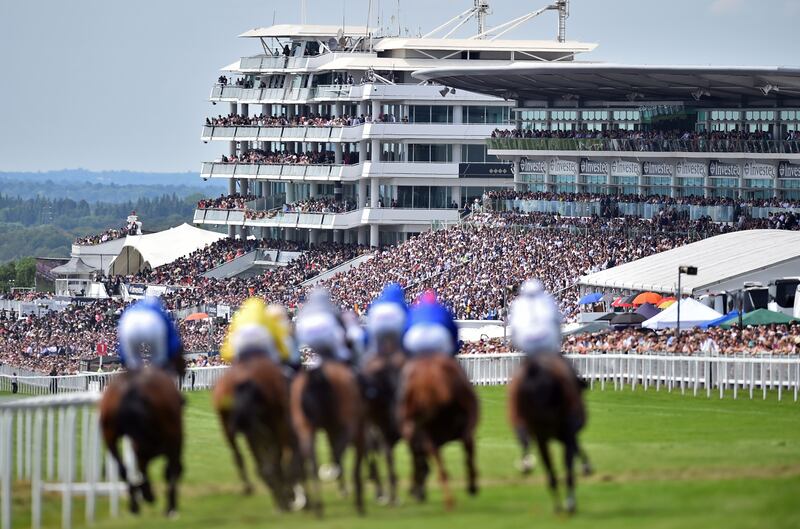This space is usually engaged in cribbing about something, on the basis there’s usually plenty to legitimately complain about. But not this time. In advance of three major classic races in three days it’s a miserable outlook that can’t glory in anticipation of perhaps the best 72 hours in flat racing.
Today’s Betfred Oaks at Epsom and tomorrow’s Derby, followed on Sunday by the Prix Du Jockey Club is an unequalled concentration of classic quality. These are races that have defined the sport for umpteen generations. If it doesn’t float your boat, it’s time to jump off the good ship Gee-Gee because this is as good as it gets.
It will be the 245th Derby tomorrow. The rather lordly verdict by the great Italian Federico Tesio about the thoroughbred existing only because of the Derby winning post has weathered a bit over time but isn’t fit for the chipper yet. The Oaks is even older than the Derby, first run in 1779. In comparison, the Jockey Club, the French Derby, is a mere pup at 188 years old.
What they continue to represent is the defining test of Europe’s best three-year-old talent. Sporting class is tricky to define. But as good a characterisation as any in thoroughbred racing is the capacity to carry speed over distance. For more than two centuries, Epsom’s mile-and-a-half test, particularly, has come to define it.
READ MORE
In its own weird, counterintuitive way, this unlovely piece of Surrey hillside remains the ultimate examination of a thoroughbred. That’s despite not an inch of it being level. Never is a horse not climbing, descending, turning, or working to keep balanced. Only a madman would design a folly of a track like this from scratch, and yet there’s still no more valid a test of horse and rider in the sport.

The bucolic paradise of Chantilly to the north of Paris is a much more regulation examination but with its own distinctive architectural folly. The magnificent Great Stables that dominate the panorama were built in the early 18th century by the Prince of Bourbon-Conde who believed in reincarnation and hoped to come back as a horse. His reluctance to rough it no matter what the circumstances helped produce an incomparable sporting backdrop.
It is a mix of history and the contemporary that makes for such a vital perspective over the coming days. Tipping over into mawkishness is always a risk. But there is no ignoring either how these races are history on the hoof, particularly in conjunction with racing’s flip side of the bloodstock coin. These 2½ minutes of competition reverberate through generations.
The breeding industry’s fluctuating fashions are reflected in how Sunday is the 20th ‘Jockey Club’ since it was reduced in distance from the classic European distance of a mile and a half in 2005. If traditionalists are still appalled, there is little argument with how the move has filled its brief in becoming a stepping stone to significant stallion success.
Shamardal, Lope De Vega and New Bay promise to be major influences on the breed for years to come. There’s a lot of Coolmore investment bound up in Aidan O’Brien’s 2021 winner, St Mark’s Basilica, following in their footsteps. In comparison, success over Epsom’s mile and a half has sadly become almost a black mark in elite commercial breeding terms.
Recent winners such as Workforce, Pour Moi, Golden Horn, Wings Of Eagles and Harzand have wound up standing in the comparative poor house of National Hunt. Godolphin packed Adayar off to Japan straight away. It could be worse. The 2020 hero Serpentine became the first winner in over a century to be gelded, apparently more useful as a racehorse in Australia than in the breeding shed.

It’s ironic then that the outstanding sire of this and perhaps any generation, Galileo, was a mile-and-a-half horse through and through, never as impressive as in his 2001 Derby romp around Epsom. He was a son of Sadlers Wells, himself a runner-up in an outstanding French Derby 40 years ago.
However, while it may not be Europe’s unarguable stallion making race anymore, the Derby’s allure remains. All human life mightn’t be present at Epsom in the manner of the famous Victorian ‘Derby Day’ painting, but history gives what will occur at 4.30pm tomorrow an unparalleled epic grandeur.
Should Aidan O’Brien secure a 10th success he will eclipse Lester Piggott as the Derby’s most successful trainer or jockey. He has the favourite City Of Troy, and also has the top two in the betting for today’s Oaks. On Sunday, Diego Velazquez is most bookies’ idea of the winner at Chantilly. No one has ever won the three races in the same year.
Should the remarkable Irishman pull it off, only time is likely to put an appropriate perspective on the scale of any such accomplishment. But in the here and now the finding out makes for a prospect to relish.
Something for the Weekend
In the circumstances it would be churlish not to chance a classic trifecta so EZELIYA (4.30) in the Oaks to kick off. Despite her sire Dubawi never having an Epsom classic winner, Dermot Weld thinks she’s an ideal candidate. The filly’s trial victory at Navan was all but faultless.
Given his Guineas flop, faith in City Of Troy’s chance rests solely in O’Brien’s transformative powers. It might work out, but stable companion LOS ANGELES (4.30) has a much more orthodox shout.
The draw plays far too much of a role around Chantilly’s 10½ furlongs but, given a fair crack of the whip, England’s GHOSTWRITER (3.05) has a big shout given a very decent effort in the Newmarket 2,000 Guineas.


















